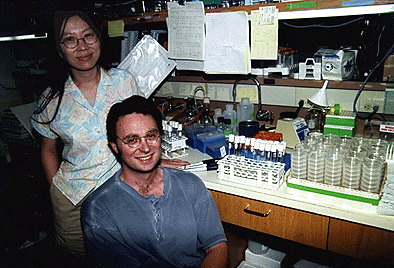![[Currents header graphic]](/homeart/currents_header.gif)
![[Currents header graphic]](/homeart/currents_header.gif)
October 13, 1997

|
|
Yishi Jin and Andrew Chisholm
|
Worms are turning up by the thousands in a pair of labs at UCSC's Biology Department. But these are not earthworms, and the work is no fishing expedition. Rather, scientists Andrew Chisholm and Yishi Jin are conducting forefront research on the hidden world of C. elegans, a minuscule nematode that is teaching us volumes about how life unfolds.
The transparent worm, one millimeter long, looks uninspiring in your hand or a petri dish. But under a microscope it's serpentine and graceful, various cells glowing under the influence of a biologist's stains. It's simple enough to consist of just 959 cells as an adult, yet complex enough that we can see many crucial human developmental processes mirrored in its three-day life cycle.
Biologists in about 200 labs around the world explore the many puzzles posed by C. elegans. How do specialized cells, such as neurons and muscles, arise from the fertilized egg? How do these cells know which of their genes to "turn on," and when? What happens as the cells age, and what determines when they die?
Targeted inquiries within those areas gradually help biologists assemble each puzzle, piece by piece. For instance, Chisholm focuses on how the worm's skin forms while it is an embryo, and how this sheath of cells encompasses the rest of the organism. The work promises to shed light on cell-cell communication, metastasis, and certain genes that may contribute to cancer. Jin probes the development of synapses--junctions among neurons that allow the nervous system to function. This poorly understood process affords neurobiologists a glimpse of the abilities of nerves to regenerate and reconnect, rather than becoming hard-wired at birth.
In the close-knit C. elegans research community, these studies have marked Chisholm and Jin as rising talents. They already have earned impressive laurels since joining UCSC's faculty 18 months ago. Both won grants for about $200,000 per year from the National Institutes of Health in the most competitive "R01" category. And the Alfred P. Sloan Foundation recognized their potential with prestigious fellowships worth $35,000 annually for two years.
Indeed, Chisholm and Jin are thriving during this hectic time of launching their labs, teaching classes, writing grant proposals, working toward tenure, and the other challenges of being assistant professors. Added to that, now, is a new son: Julian, born August 26. Chisholm and Jin are married, having met as postdoctoral researchers at the Massachusetts Institute of Technology.
When the pace becomes overwhelming, it's a good bet to look for either of these researchers not in their offices but at a microscope, studying their worms.
"For me, they are mind-settling," says Jin. "If I'm angry or under stress, they help me relax. They are such a part of my life."
Chisholm regards C. elegans as "old friends, but they definitely hold surprises for you. To someone who has never looked at them, they're boring. But under a nice microscope, they are very beautiful, clean, and precise."
Within the next few months, biologists at other institutions will finish a monumental effort to spell out the worm's entire genetic code, comprising some 100 million "letters," or fundamental units of DNA. C. elegans will be the first multicellular organism with a fully sequenced genome; the human genome, some 30 times larger, won't be finished until the middle of the next decade.
With the genome in hand, biologists no longer will need to embark on the "nightmarish saga," in Chisholm's words, of hunting and pecking for genes of interest. All of the C. elegans genes, more than 15,000 of them, will be exposed, waiting for enterprising scientists to scrutinize their functions.
It's fascinating, the researchers say, to note the similarity between many of the worm's genes and our own, especially among genes whose functions are essential to life. That's why C. elegans and biology's other model organisms--yeast, fruit fly, mouse--are so valuable to fleshing out our understanding of human developmental biology and diseases.
C. elegans has proven most useful for yielding a complete descriptive anatomy of a complex organism, from egg to 959-cell adult. Scientists understand the fates of each of those cells. Teasing apart the genetic controls that dictate such fates--the "pathways" of genes involved in each process, as Jin says--is considerably more challenging.
As postdoctoral researchers, Jin and Chisholm each published C. elegans papers in Nature, one of the world's leading scientific journals. Their studies at UCSC are still too nascent to have resulted in such publications--but don't be surprised, their colleagues say, to see them ascend rapidly to the field's top tier.
The two biologists restore a Santa Cruz-C. elegans connection fostered for many years by professor emeritus of biology Robert Edgar, who retired in 1991. One of the discipline's notable scientists, Edgar launched in 1975 the Worm Breeder's Gazette, a publication in which worm biologists unhesitatingly share their latest data and techniques. The cover art of each edition features worms, naturally, in various playful guises.